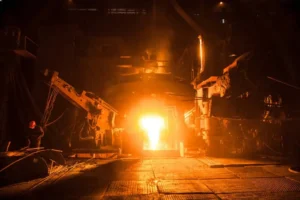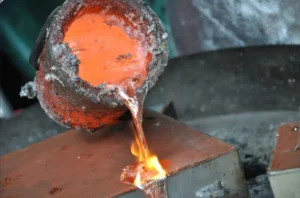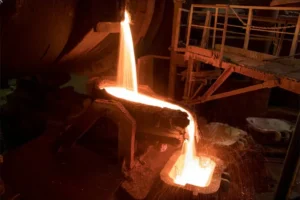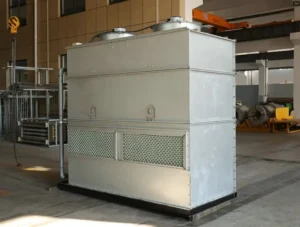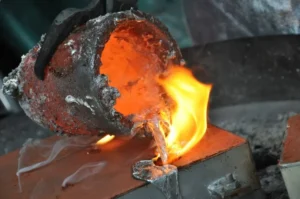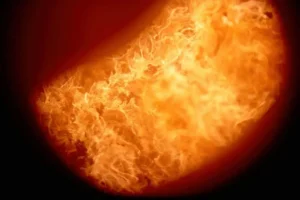Trong lĩnh vực hiện đại của kim loại tan chảy và giữ, Lò cảm ứng không có dây và có được hai công nghệ gia nhiệt cảm ứng điện từ chính thống. Mỗi người đóng một vai trò không thể thiếu trong các kịch bản công nghiệp khác nhau, phân biệt bởi các thiết kế kết cấu độc đáo của họ, Nguyên tắc hoạt động, và đặc điểm ứng dụng.
Sự khác biệt cốt lõi trong nháy mắt
| Tính năng | Lò nung cảm ứng không lõi | Đã được điều khiển (Kênh) Lò nung cảm ứng |
| Cấu trúc cốt lõi | Không có lõi sắt; Kim nấu ăn được bao quanh trực tiếp bởi cuộn dây cảm ứng. | Có lõi thép nhiều lớp đi qua cuộn dây cảm ứng. |
| Nguyên tắc sưởi ấm | Trường điện từ trực tiếp gây ra dòng điện trong vật liệu điện tích, Tạo nhiệt Joule. | Hành động như một máy biến áp; lõi sắt một cách hiệu quả các từ trường thành kênh kim loại nóng chảy. |
| Phương pháp bắt đầu | Có thể được bắt đầu từ trạng thái lạnh; không yêu cầu một gót chân nóng chảy. | Yêu cầu một gót chân nóng chảy hoặc khối bắt đầu để bắt đầu; không thể được làm trống. |
| Hệ số công suất | Thấp hơn, tiêu biểu 0.1-0.3, yêu cầu bồi thường tụ điện đáng kể. | Cao hơn, tiêu biểu 0.6-0.8, cho phép sử dụng năng lượng điện hiệu quả hơn. |
| Hiệu suất nhiệt | Hiệu quả nóng chảy cao hơn, Nhưng hiệu quả nắm giữ tương đối thấp hơn. | Hiệu quả nắm giữ cực kỳ cao (>95%), Nhưng khả năng nóng chảy hạn chế. |
| Tính linh hoạt | Vô cùng cao; có thể được bắt đầu và dừng lại theo ý muốn, dễ dàng chuyển đổi giữa các hợp kim khác nhau. | Nghèo; thường dành riêng cho một hợp kim duy nhất, vì thay đổi hợp kim là tốn kém và khó khăn. |
| Sử dụng chính | Làm tan chảy các kim loại khác nhau; Thích hợp cho sản xuất không liên tục và yêu cầu hợp kim đa dạng. | Nắm giữ lâu dài, quá nóng, và điều chỉnh thành phần của một khối lượng lớn của một kim loại lỏng. |
| Các ứng dụng điển hình | Xưởng đúc (Thép, sắt, đồng, nhôm, vân vân.), kim loại quý tan chảy. | Giữ lò nung trong các xưởng đúc lớn và cây đúc chết, Giữ các đơn vị trong các hoạt động song công. |
TÔI. So sánh cấu trúc
Lò nung cảm ứng không lõi
Lò nung cảm ứng không chính xác, còn được gọi là lò nung cảm ứng loại nồi nấu kim loại, có cấu trúc tương đối đơn giản. Thành phần cốt lõi của nó là một cây thánh giá làm bằng vật liệu chịu lửa, được bao quanh chặt bởi một cuộn cảm ứng đồng làm mát bằng nước. Toàn bộ lắp ráp không có lõi sắt để hoạt động như một mạch từ tính.
- Cuộn cảm (Xôn xao): Trực tiếp bao quanh bên ngoài của nồi nấu kim loại và được cung cấp với dòng điện xen kẽ trung bình hoặc cao.
- nồi nấu kim loại: Giữ điện tích kim loại; Vật liệu của nó được chọn dựa trên loại kim loại đang tan chảy.
- Ách: Yokes thép nhiều lớp thường được lắp đặt bên ngoài cuộn dây để giới hạn từ trường, ngăn cấu trúc kim loại lò nung nóng, và cải thiện hiệu quả từ tính. Tuy nhiên, chúng không tạo thành một mạch từ kín.
Lò cảm ứng cored
Lò nung cảm ứng cored, Còn được gọi là lò cảm ứng kênh, có một cấu trúc gần giống với một máy biến áp. Nó có một lõi kín làm bằng các tấm thép silicon nhiều lớp.
- Lõi sắt: Tạo thành một mạch từ kín, Đảm bảo chuyển hiệu quả từ trường.
- Cuộn cảm (Sơ đẳng Xôn xao): Vết thương quanh một chân lõi sắt và được cung cấp với tần số điện hoặc tần số trung bình.
- Nóng chảy Kênh (Sơ trung Xôn xao): Thân máy bao gồm một hoặc nhiều kênh hình vòng chứa kim loại nóng chảy. Kênh này bao quanh chân lõi với cuộn cảm, và kim loại nóng chảy trong nó hoạt động như cuộn thứ cấp ngắn mạch của máy biến áp. Lò sưởi lò chính được kết nối với kênh này, và nhiệt được chuyển từ kênh sang toàn bộ bồn tắm kim loại.
Ii. Phân tích các nguyên tắc hoạt động
Lò nung cảm ứng không lõi
Hoạt động của nó dựa trên Hệ thống sưởi trực tiếp thông qua Cảm ứng điện từ. Khi một dòng điện xen kẽ chảy qua cuộn cảm ứng, nó tạo ra một, từ trường xen kẽ trong buồng lò. Theo Luật Cảm ứng điện từ của Faraday,, Từ trường thay đổi này thâm nhập vào điện tích kim loại trong nồi nấu kim loại và tạo ra các vòng kín của dòng điện trong điện tích dẫn điện, được biết đến như Dòng điện xoáy.
Khi các dòng xoáy này chảy qua điện tích kim loại điện trở, Họ tạo ra một lượng lớn Joule Heat (Q = i2rt), khiến điện tích nóng lên và tan chảy nhanh chóng. Ngoài ra, các lực điện từ tạo ra một hành động khuấy mạnh trong kim loại nóng chảy, giúp đồng nhất hóa thành phần hóa học và nhiệt độ của kim loại lỏng.
Lò cảm ứng cored
Nguyên tắc hoạt động của nó cực kỳ giống với máy biến áp.
- Truyền năng lượng: AC chảy qua cuộn dây chính (cuộn cảm), tạo ra một thông lượng từ tính xen kẽ trong lõi sắt kín.
- Cảm ứng sưởi ấm: Thông lượng từ tính này được hướng dẫn một cách hiệu quả và gần như không mất mát thông qua cuộn dây thứ cấp, đó là kênh kim loại nóng chảy. Nó tạo ra một dòng điện mạnh mẽ trong kim loại nóng chảy trong kênh.
- Tạo nhiệt và lưu thông: Dòng điện lớn này tạo ra nhiệt độ nhiệt độ cao trong kênh. Do lực điện từ và đối lưu nhiệt (các “hiệu ứng động cơ” Và “Hiệu ứng Thermosiphon”), kim loại lỏng quá nhiệt tăng từ kênh vào lò sưởi chính, Trong khi kim loại mát hơn từ lò sưởi chìm vào kênh. Điều này tạo ra sự lưu thông liên tục, do đó làm nóng và duy trì nhiệt độ của toàn bộ bồn tắm kim loại.
Iii. Kịch bản ứng dụng
Lò nung cảm ứng không lõi: Linh hoạt “METING MASTER”
Nhờ khả năng bắt đầu từ lạnh và dễ dàng thay đổi vật liệu điện tích, lò nung cảm ứng Corless cung cấp tính linh hoạt hoạt động đặc biệt.
- Kịch bản phù hợp:
- Đa hợp đồng, Sản xuất hàng loạt: Lý tưởng cho các xưởng đúc cần thường xuyên chuyển đổi giữa các loại kim loại khác nhau, chẳng hạn như các loại thép khác nhau, sắt dễ uốn, Hợp kim đồng, và hợp kim nhôm.
- Hoạt động không liên tục: Có thể được bắt đầu và dừng lại bất cứ lúc nào, phù hợp với lịch trình sản xuất thay đổi hoặc thay đổi kép.
- Phế liệu tan chảy: Nó không đòi hỏi về hình dạng và kích thước của vật liệu điện tích và có thể làm tan chảy các loại kim loại phế liệu một cách hiệu quả.
- Phòng thí nghiệm và r&D: Lò không có trọng lượng quy mô nhỏ là một lựa chọn lý tưởng để phát triển vật liệu mới và thử nghiệm quy trình.
Lợi thế cốt lõi: Linh hoạt cao, Tốc độ nóng chảy nhanh, và khả năng được làm trống hoàn toàn, giúp đơn giản hóa việc làm sạch và bảo trì.
Lò cảm ứng cored: Hiệu quả & Ổn định “Giữ chuyên gia”
Do nguyên tắc hoạt động của nó, Một lò nung cảm ứng phải luôn luôn duy trì gót kim loại nóng chảy trong kênh của nó. Nó không thể dừng lại hoặc làm trống, điều này làm cho nó phù hợp hơn cho các hoạt động liên tục.
- Kịch bản phù hợp:
- Dây chuyền sản xuất liên tục quy mô lớn: Được sử dụng như một lò giữ trung tâm trong các hoạt động đúc hoặc đúc lớn để cung cấp một khối lượng lớn kim loại lỏng đủ điều kiện từ một melter chính (như một chiếc cốc hoặc lò hồ quang điện) đến các máy đúc hạ nguồn.
- Hoạt động song công: Một thành phần chính trong “lò nung cảm ứng cupola” Song công, nơi nó được sử dụng để siêu nhiệt, giữ, điều chỉnh thành phần của, và thanh lọc sắt khai thác từ cupola.
- Khối lượng lớn, Sản xuất hợp kim đơn: Phù hợp cho các ứng dụng liên quan đến lâu dài, Sản xuất quy mô lớn của một kim loại hoặc hợp kim, chẳng hạn như các lò nung nóng và giữ trong các nhà máy đúc bằng nhôm lớn.
Lợi thế cốt lõi: Hiệu suất điện và nhiệt cực cao, Tiêu thụ năng lượng rất thấp để giữ, và sự ổn định đặc biệt của nhiệt độ và thành phần kim loại lỏng.
Phần kết luận
Tóm lại, Không có sự vượt trội tuyệt đối giữa lò nung cảm ứng không có quyền lực và không có được; hơn là, Chúng là những thiết kế được tối ưu hóa cho các nhu cầu công nghiệp khác nhau. Lò nung cảm ứng không chính xác, với sự linh hoạt vô song của nó, là lựa chọn hàng đầu cho các nhiệm vụ nóng chảy thay đổi. Lò nung cảm ứng cored, với hiệu quả nắm giữ và ổn định nổi bật của nó, Thống trị trong quy mô lớn, hoạt động giữ và tinh chế liên tục. Khi chọn, Các công ty nên xem xét đầy đủ quy mô sản xuất của họ, sản phẩm đa dạng, Dòng chảy quá trình, và chi phí hoạt động để đưa ra quyết định phục vụ tốt nhất lợi ích của họ.


